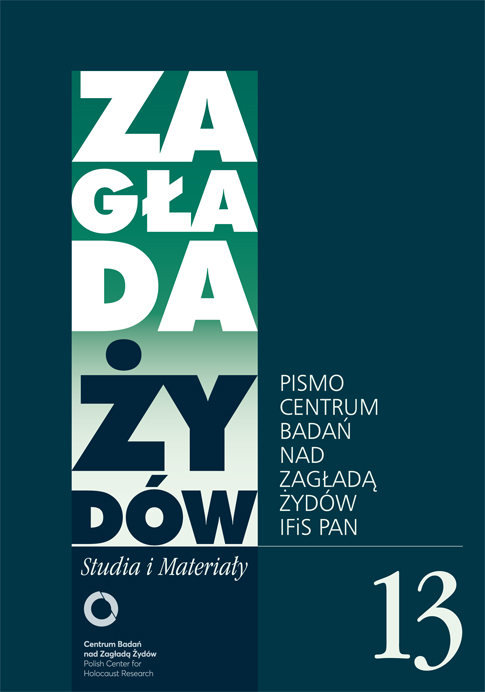Zabiegi likwidujące skutki obrzezania wykonywane w Warszawie w czasie drugiej wojny światowej. Wstępna próba opisu zjawiska
Zagłada Żydów. Studia i Materiały, Nr 13 (2017), Strony: 437-446
Data zgłoszenia: 2020-10-17Data publikacji: 2017-12-03
 https://doi.org/10.32927/ZZSiM.366
https://doi.org/10.32927/ZZSiM.366
Abstrakt
Men’s circumcision is in many countries considered as a hygienic-cosmetic or aesthetic treatment. However, it still remains in close connection with religious rites (Judaism, Islam) and is still practiced all over the world. During the Second World War the visible effects of circumcision became an indisputable evidence of being a Jew and were often used especially by the so-called szmalcownicy (blackmailers). Fear of the possibility of discovering as non-Aryan prompted many Jews hiding on the so-called Aryan side of Warsaw to seek medical practitioners who would restore the condition as it was before the circumcision. The reconstruction surgery was called in surgical jargon “knife baptizing”. Almost all of the procedures were performed by Aryan doctors although four cases of hiding Jewish doctors participating in such procedures are known. Surgical technique consisted of the surgical formation of a new foreskin after tissue preparation and stretching it by manual treatment. The success of the repair operation depended on the patient’s cooperation with the doctor, the worst result was in children. The physicians described in the article and the operating technique are probably only a fragment of a broader activity, described meticulously by only one of the doctors – Dr. Janusz Skórski. This work is an attempt to describe the phenomenon based on the very scanty source material, but it seems to be the first such attempt for several decades.
Słowa kluczowe
obrzezanie , circumcisio , zabiegi rekonstrukcyjne napletka , Janusz Skórski
Licencja
Prawa autorskie (c) 2017 Autor & "Zagłada Żydów. Studia i Materiały"

Utwór dostępny jest na licencji Creative Commons Uznanie autorstwa 4.0 Międzynarodowe.
https://creativecommons.org/licenses/by/4.0
Inne teksty tego samego autora
- Marta Ciesielska, „Dużo trudu i dużo piękna w życiu internatu”. Z Domu Sierot Janusza Korczaka , Zagłada Żydów. Studia i Materiały: Nr 8 (2012)
Podobne artykuły
- Jagoda Budzik, Nasz brat Max Aue. „Punkt zero: Łaskawe”, reż. Janusz Opryński, Teatr Provisorium , Zagłada Żydów. Studia i Materiały: Nr 12 (2016)
- Redakcja, Od Redakcji , Zagłada Żydów. Studia i Materiały: Nr 13 (2017)
- Janusz Salamon, SJ, Dialog chrześcijańsko-żydowski w krainie schorowanej wyobraźni. Na marginesie książki Waldemara Chrostowskiego Kościół, Żydzi, Polska , Zagłada Żydów. Studia i Materiały: Nr 5 (2009)
- Janusz Marszalec, Morderstwo na Makowieckich i Widerszalu. Stara sprawa, nowe pytania, nowe wątpliwości. , Zagłada Żydów. Studia i Materiały: Nr 2 (2006)
- Janusz Salamon, SJ, Christian-Jewish Dialogue in the Land of Sick Imagination. On the Margins of Waldemar Chrostowski’s Book Kościół, Żydzi, Polska , Zagłada Żydów. Studia i Materiały: 2010: Holocaust Studies and Materials
- Krzysztof Czubaszek, Stanisław Żemis – świadek zagłady Żydów w Łukowie , Zagłada Żydów. Studia i Materiały: Nr 14 (2018)
- Agnieszka Witkowska-Krych, Joanna Beata Michlic, Piętno Zagłady. Wojenna i powojenna historia oraz pamięć żydowskich dzieci ocalałych w Polsce [Agnieszka Witkowska-Krych] , Zagłada Żydów. Studia i Materiały: Nr 17 (2021)
Możesz również Rozpocznij zaawansowane wyszukiwanie podobieństw dla tego artykułu.
 English
English
 Język Polski
Język Polski



 https://orcid.org/0000-0002-5750-3106
https://orcid.org/0000-0002-5750-3106





